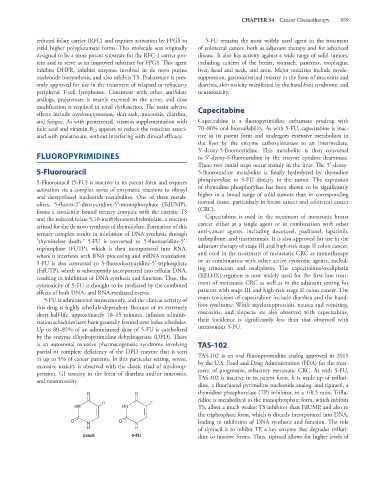Page 973 - Basic _ Clinical Pharmacology ( PDFDrive )
P. 973
CHAPTER 54 Cancer Chemotherapy 959
reduced folate carrier (RFC) and requires activation by FPGS to 5-FU remains the most widely used agent in the treatment
yield higher polyglutamate forms. This molecule was originally of colorectal cancer, both as adjuvant therapy and for advanced
designed to be a more potent substrate for the RFC-1 carrier pro- disease. It also has activity against a wide range of solid tumors,
tein and to serve as an improved substrate for FPGS. This agent including cancers of the breast, stomach, pancreas, esophagus,
inhibits DHFR, inhibits enzymes involved in de novo purine liver, head and neck, and anus. Major toxicities include myelo-
nucleotide biosynthesis, and also inhibits TS. Pralatrexate is pres- suppression, gastrointestinal toxicity in the form of mucositis and
ently approved for use in the treatment of relapsed or refractory diarrhea, skin toxicity manifested by the hand-foot syndrome, and
peripheral T-cell lymphoma. Consistent with other antifolate neurotoxicity.
analogs, pralatrexate is mainly excreted in the urine, and dose
modification is required in renal dysfunction. The main adverse Capecitabine
effects include myelosuppression, skin rash, mucositis, diarrhea,
and fatigue. As with pemetrexed, vitamin supplementation with Capecitabine is a fluoropyrimidine carbamate prodrug with
folic acid and vitamin B appears to reduce the toxicities associ- 70–80% oral bioavailability. As with 5-FU, capecitabine is inac-
12
ated with pralatrexate, without interfering with clinical efficacy. tive in its parent form and undergoes extensive metabolism in
the liver by the enzyme carboxylesterase to an intermediate,
5′-deoxy-5-fluorocytidine. This metabolite is then converted
FLUOROPYRIMIDINES to 5′-deoxy-5-fluorouridine by the enzyme cytidine deaminase.
These two initial steps occur mainly in the liver. The 5′-deoxy-
5-Fluorouracil 5-fluorouridine metabolite is finally hydrolyzed by thymidine
5-Fluorouracil (5-FU) is inactive in its parent form and requires phosphorylase to 5-FU directly in the tumor. The expression
activation via a complex series of enzymatic reactions to ribosyl of thymidine phosphorylase has been shown to be significantly
and deoxyribosyl nucleotide metabolites. One of these metab- higher in a broad range of solid tumors than in corresponding
olites, 5-fluoro-2′-deoxyuridine-5′-monophosphate (FdUMP), normal tissue, particularly in breast cancer and colorectal cancer
forms a covalently bound ternary complex with the enzyme TS (CRC).
and the reduced folate 5,10-methylenetetrahydrofolate, a reaction Capecitabine is used in the treatment of metastatic breast
critical for the de novo synthesis of thymidylate. Formation of this cancer either as a single agent or in combination with other
ternary complex results in inhibition of DNA synthesis through anti-cancer agents, including docetaxel, paclitaxel, lapatinib,
“thymineless death.” 5-FU is converted to 5-fluorouridine-5′- ixabepilone, and trastuzumab. It is also approved for use in the
triphosphate (FUTP), which is then incorporated into RNA, adjuvant therapy of stage III and high-risk stage II colon cancer,
where it interferes with RNA processing and mRNA translation. and used in the treatment of metastatic CRC as monotherapy
5-FU is also converted to 5-fluorodeoxyuridine-5′-triphosphate or in combination with other active cytotoxic agents, includ-
(FdUTP), which is subsequently incorporated into cellular DNA, ing irinotecan and oxaliplatin. The capecitabine/oxaliplatin
resulting in inhibition of DNA synthesis and function. Thus, the (XELOX) regimen is now widely used for the first-line treat-
cytotoxicity of 5-FU is thought to be mediated by the combined ment of metastatic CRC as well as in the adjuvant setting for
effects of both DNA- and RNA-mediated events. patients with stage III and high-risk stage II colon cancer. The
5-FU is administered intravenously, and the clinical activity of main toxicities of capecitabine include diarrhea and the hand-
this drug is highly schedule-dependent. Because of its extremely foot syndrome. While myelosuppression, nausea and vomiting,
short half-life, approximately 10–15 minutes, infusion adminis- mucositis, and alopecia are also observed with capecitabine,
tration schedules have been generally favored over bolus schedules. their incidence is significantly less than that observed with
Up to 80–85% of an administered dose of 5-FU is catabolized intravenous 5-FU.
by the enzyme dihydropyrimidine dehydrogenase (DPD). There
is an autosomal recessive pharmacogenetic syndrome involving TAS-102
partial or complete deficiency of the DPD enzyme that is seen TAS-102 is an oral fluoropyrimidine analog approved in 2015
in up to 5% of cancer patients. In this particular setting, severe, by the U.S. Food and Drug Administration (FDA) for the treat-
excessive toxicity is observed with the classic triad of myelosup- ment of progressive, refractory metastatic CRC. As with 5-FU,
pression, GI toxicity in the form of diarrhea and/or mucositis, TAS-102 is inactive in its parent form. It is made up of trifluri-
and neurotoxicity.
dine, a fluorinated pyrimidine nucleoside analog, and tipiracil, a
O O thymidine phosphorylase (TP) inhibitor, in a 1/0.5 ratio. Triflu-
ridine is metabolized to the monophosphate form, which inhibits
H F
HN HN TS, albeit a much weaker TS inhibitor than FdUMP, and also to
the triphosphate form, which is directly incorporated into DNA,
O O leading to inhibition of DNA synthesis and function. The role
N N
H H of tipiracil is to inhibit TP, a key enzyme that degrades trifluri-
Uracil 5-FU dine to inactive forms. Thus, tipiracil allows for higher levels of

